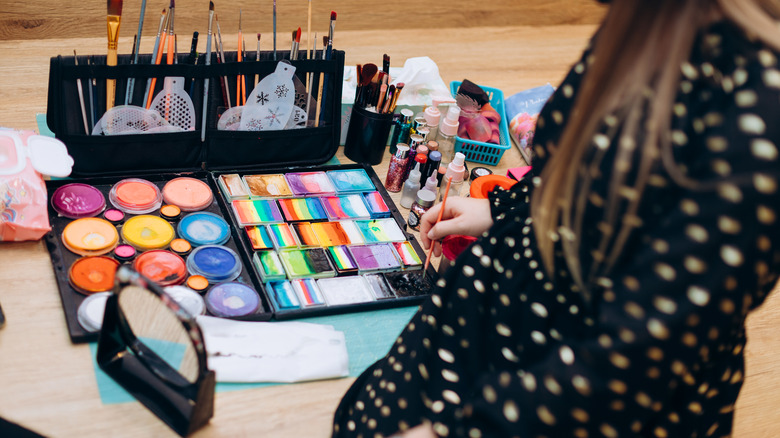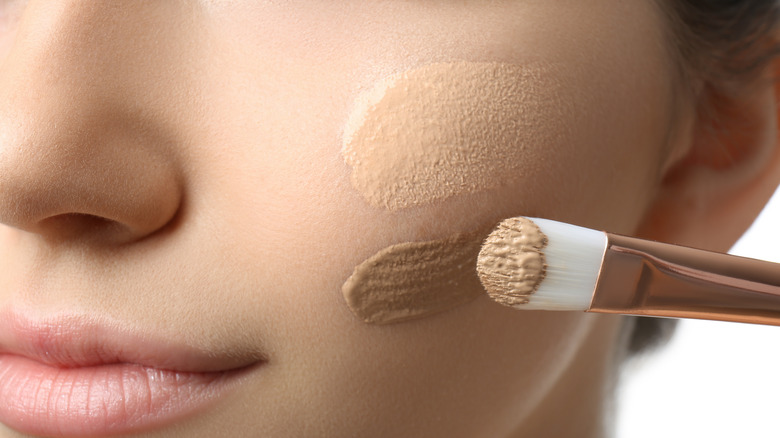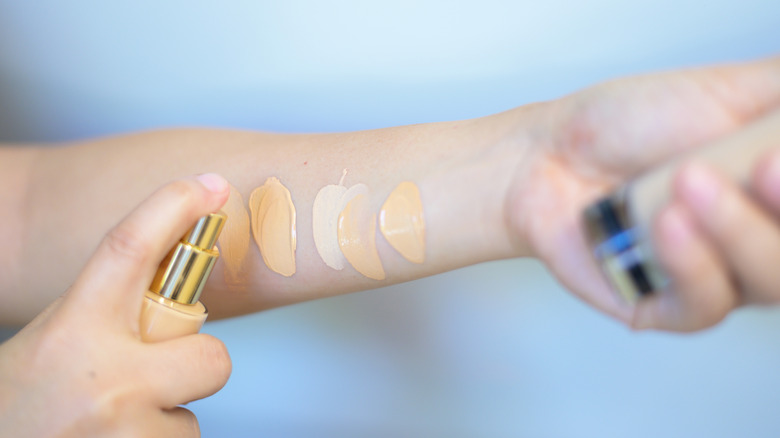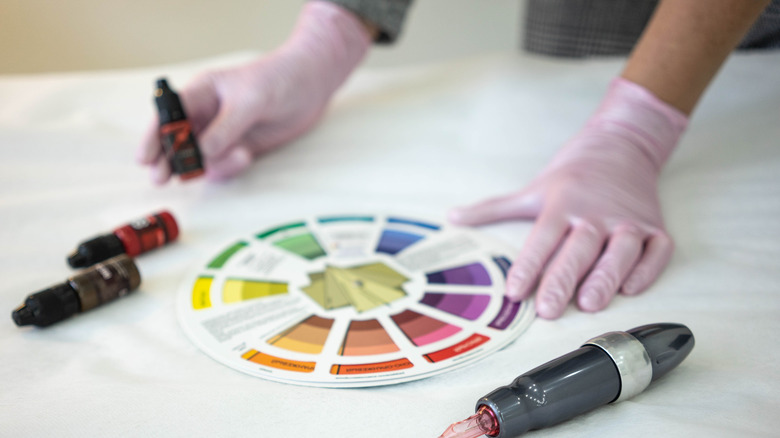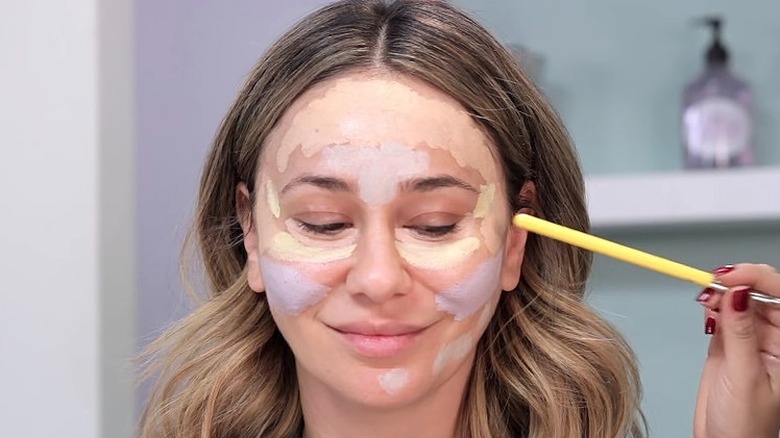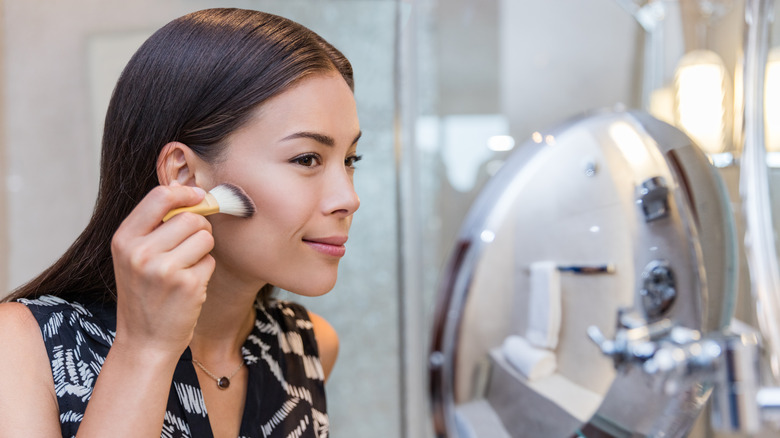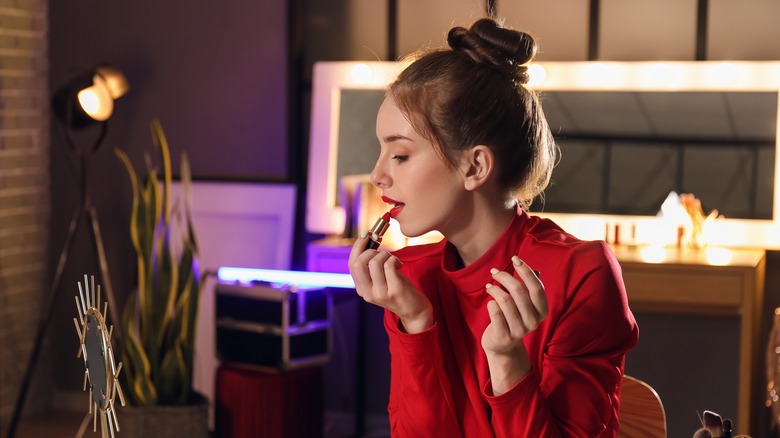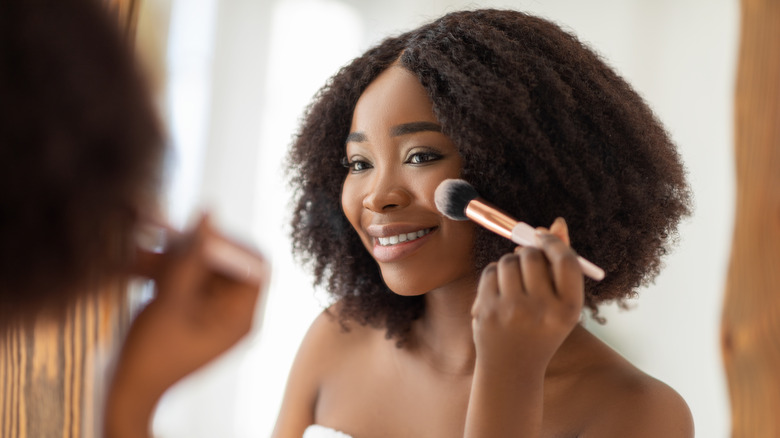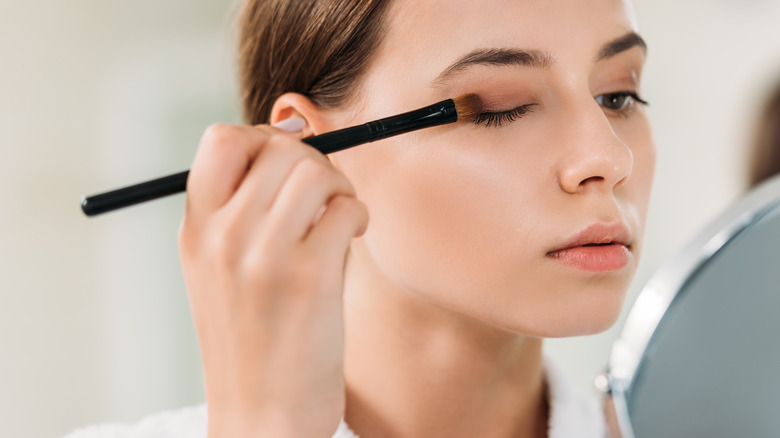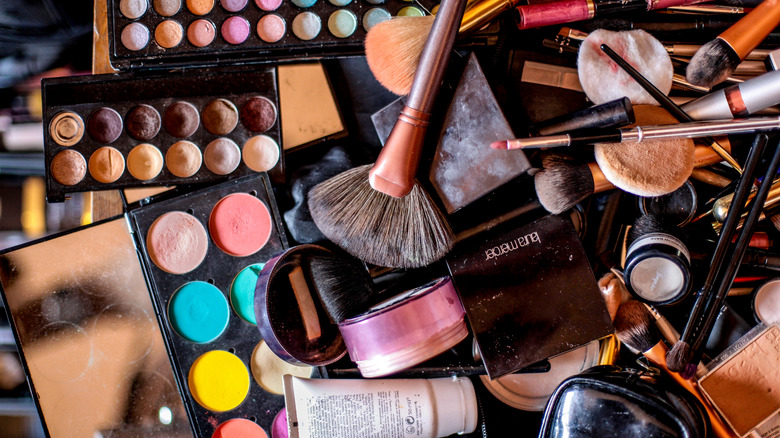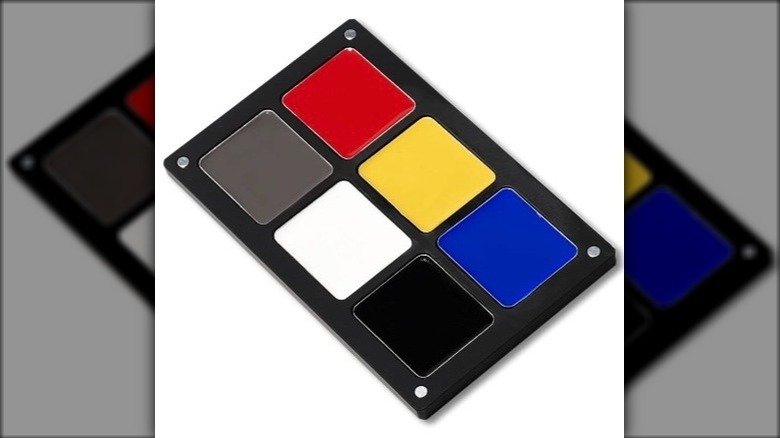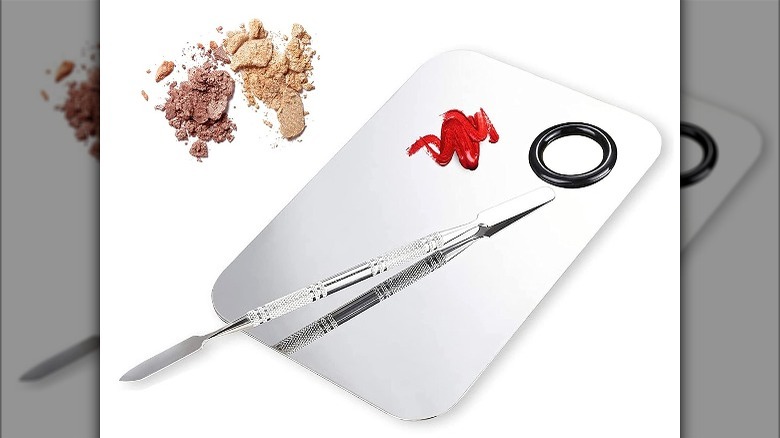Our Complete Guide To The Color Theory Makeup Trend
We may receive a commission on purchases made from links.
There are thousands of ways to apply makeup and even more ways to wear it. If you're anything like us, you're constantly on TikTok and Instagram ogling over the beautiful looks makeup artists create on themselves and others, making note of their techniques and adding products to your virtual Sephora cart. You might even pause to try the look yourself, only to discover you don't have the same colors as the artist you're watching, forcing you to make do with what you have.
While doing so also forces you to flex your creative muscles, there is a way to match your makeup to what you see on screen and create legions more looks while you're at it — without purchasing a new pigment every time you have color envy. It's called color theory makeup. If you've seen a TikTok or Instagram Reel of someone color-matching a paint swatch, that's color theory. If you've seen someone applying dots of color on their face to perfectly shade-match their foundation, that's color theory makeup.
But color theory makeup is far more than just applying dots to your face and magically blending to match your skin tone. It's an art and a science, and it's worth learning about if you want to up your makeup game. Keep reading for our complete guide to the color theory makeup trend.
Learn the basics of color theory makeup
Color theory, like most theories, is based on science. According to the Smithsonian, Sir Isaac Newton did the important work of discovering the color spectrum, which is the basis of color theory. Since then, several other scientists have added to his work to guide how we produce color today. Thanks to those scientists, people throughout history have been able to dye fabrics for clothing, create art materials, and, of course, apply makeup.
Today, color theory is used by artists, graphic designers, interior decorators, and more. Although we call color theory makeup a "trend," color theory has been around much longer than any of us have been alive, and it's used for much more than just makeup application.
Color theory is how colors are created and how they relate to one another. When makeup products are created, the manufacturing process is guided by — you guessed it — color theory. Color theory makeup is simply using the theory of color to guide your makeup choices. It's an incredibly useful skill, but it does require a bit more breakdown to fully understand it. We'll start by discussing the specifics of color theory makeup, then touch on how to apply it to our own faces.
Make sure you understand undertones
The core of color theory makeup is understanding your skin undertones. Your undertones are the shades that sit underneath your skin tone. On the surface, our skin colors are all different, but underneath, we all fall into three main categories: cool, warm, or neutral. To apply makeup according to color theory, you need to first learn what your undertones are and what colors fall into those categories. For example, if you have cool undertones, your undertones are built on cool shades, like blues and pinks. If you have warm undertones, then your undertones are built on warm shades, like yellows and peaches.
Identifying your undertones is easier than you might think. You could see a color specialist at a makeup counter or use gold and silver jewelry as a guide, but the simplest way to determine your undertones is by using the veins in your wrist. If your veins appear blue or purple, you have cool undertones. If they appear green or olive, you have warm undertones. If they appear both blue and green, you have neutral undertones. Your undertones will help you create a shade match from scratch and help you decide which colors best suit your face.
Use the color wheel
Color theory makeup can be very intimidating, especially if you don't have a good handle on cool versus warm colors. But luckily for us, like with many sciences, color theory has a handy-dandy guide to help. That guide is called the color wheel. Yes, we are talking about that color wheel — the one that we studied in elementary school. And just what were we studying? Yep, color theory. As it turns out, some things we learn in elementary school are actually useful in adulthood.
But back to the color wheel. The color wheel is so useful because it shows us which colors are cool, which are warm, and which are primary, secondary, tertiary, and complementary. When you're shade matching, you need to know which colors are cool and which are warm.
When you're color correcting (we'll get into that in a moment), you need to know which colors are complementary. The rest of the information is helpful in determining which colors will look best when applying products like eyeshadow, blush, and lip color. Whether you're just diving into color theory makeup or a pro, the color wheel is a tremendous tool that can help you make choices more confidently and provide reassurance.
Start with color-correction concealer
If you're just getting started with color theory makeup, a good place to start is color correction concealer. You've probably heard of this practice, especially if you suffer from acne, rosacea, eczema, or any other skin condition that causes your skin to turn red. Color-correction concealer is the idea that you can neutralize your skin tone by offsetting whatever color is showing up on your face with its complementary color. For example, if you are trying to cover a blemish, you have perhaps been advised to apply a green color corrector on top of your blemish to neutralize its color, as green and red are complementary colors.
Color-correction concealer goes far beyond redness, though. If you have other facial insecurities, like dark circles or bruises, you can also use this method to cover those places on your face. All it takes is determining the complementary color and applying a concealing product in that shade. Dark circles, for example, are typically covered with a peach or orange concealing product.
Practicing with color-correction concealer will familiarize you with the idea of complementary colors and help you better understand how to put color theory into practice. If you don't have areas on your face that need color-correcting (first, let us know your skincare routine), then find another place on your body to practice. Color theory will remain the same, no matter where you're applying makeup on your body.
Move to color theory foundation
Once you've mastered color-correction concealer, you're ready to move on to color theory foundation. Color theory foundation is simply putting the tenets of color theory into work to either shade match or create your own foundation. Let's start with creating your own shade. And be warned: It will likely take some trial and error to master.
To start, apply the primary colors — blue, red, and yellow — to your face. When combined, these three colors will make a shade of brown. Depending on your skin tone, you may have to add some white to lighten your shade. And depending on your undertones, you'll probably have to add more of one of the three primary colors than the others to arrive at your true shade. Color theory foundation is all about balancing the colors until they've been mixed properly.
Now onto shade matching. This is a bit different than creating your foundation from scratch, and it's likely something you already do, especially if your skin tone changes throughout the year. Color theory principles can be applied to shade matching if you've just gotten a spray tan, you're losing your summer glow, or you've purchased a foundation that isn't the right shade. Instead of constantly buying new foundations, work with what you have and buy pigmented drops that are either lighter or darker to adjust the shade as necessary. It'll save you time and money.
Use the color theory for your lips
Color theory is not limited to your skin tone. You can also use the theory for the bolder portions of your makeup routine, like your lips. And for as much trouble as many of us have to find an exact shade match for foundation, it might be an even bigger task to find a lip color that we like. If you are one of those people struggling to find a good color, use color theory makeup to create your own instead.
As we know, the primary colors mixed together will create a shade of brown. If you're after a brown lip, start with the primary colors and add more of one color to adjust the shade until you're satisfied, and add black or white if you want it to be a little lighter or darker. If you're after pink, blend red and white.
Feel free to add other primary colors, as well as secondary and tertiary colors, until you've arrived at the shade you like. Have fun with it! Remember, though, this is simply for the pigment. Unless you have access to a cosmetic lab, you're likely not going to be able to create your own custom lip product and will have to mix the pigment with another product, like a clear lip gloss or a balm, to put on your lips. Otherwise, you risk severely drying out your lips.
Use it for blush, too
Color theory can also be used for blush. You can follow the same steps as you would for a custom foundation or lip color to find a custom blush color (you can follow those steps for contour and concealer, too), and just omit one or more of the primary colors to avoid a brown blush. But if you prefer a powder blush over a cream or liquid blush, use color theory as a guide for which color product to buy rather than creating a custom color. To do this, let's go back to our undertones.
Once again, the basic undertones are cool, warm, and neutral. Pink, berry, and fuschia are cool. Coral and peach are warm. Mauve is neutral. Now, just because you have cool undertones doesn't mean you should only buy pink, berry, and fuschia blushes. This information is simply a guide to help you determine which shade will help you achieve a certain look.
If you want a subtle look, stick to a blush that matches your undertones. But if you want a look that's bold, opt for a complementary blush. Knowing your undertones and understanding color theory isn't meant to restrict your makeup choices — it's meant to guide your choices to create stunning looks with perfectly matched and selected shades.
Test the color theory with your eyes
When it comes to the eyes, color theory makeup is going to be more similar in application to blush than it is to lips and face, particularly for shadow. Since you're likely not creating your own shades and custom palettes, use what you know about color theory to guide what products you purchase and how you create a shadow look.
Use the color wheel to remind you which shades are warm and cool, and consult your undertones when choosing whether to go subtle or bold. Again, for a soft glam look, match the tones to your undertones. For something bolder, use complementary colors. The eyes are a special area of the face when it comes to color theory makeup, though, because of the iris, or the colored part of your eye.
While you can use your undertones to guide your eye look, it's also fun to use your iris. Applying the color theory to your iris can make it pop, and this can be done with shadow, liner, or mascara. To make it stand out, consult the color wheel again to find the complementary color of your iris and use that as a shade guide for your products. For more subtle looks that still augment your iris, use analogous colors — the colors that sit next to each shade on the color wheel.
Create your entire look with color theory
Color theory can be used to build your entire makeup look — it doesn't just have to be one particular area of the face. Follow the steps we laid out to build your perfect base and keep mixing pigments for custom colors for the eyes and lips. If you can shade match, you can make custom colors to replace any product.
Remain patient as you continue learning about color theory, and remember that you can always remove your makeup and start again. Color theory should make applying makeup more fun, not more stressful.
Beyond shade matching, use your undertones to curate your entire look. Decide before you apply how bold or subtle of a look you want and in what areas. Once you've got a look in mind, keep the color wheel handy and confer whenever you're in need of guidance. Understanding color theory will enhance your look and bring depth to your creativity. It'll also allow you to apply makeup to others, making you a more versatile artist.
Use these products
If you're brand new to color theory makeup, you might've read each of these tips with one major question: What products am I supposed to use? It's a fair question — most makeup products we see are manufactured to match a particular skin tone. If you're serious about experimenting with color theory makeup, purchase a cream palette that contains, at the very least, the primary colors, along with white and black. Danessa Myricks Waterproof Cream Palette is a great choice.
This will allow you to build a base, contour, and highlight, as well as apply blush, lip color, eyeshadow, and liner. For even more looks, purchase a palette that has 12 colors. This usually will include the five aforementioned colors and some secondary and tertiary colors. These palettes are fairly expensive, but they're worth the cost if you intend to use them instead of other products. As a starting point, check out Make Up For Ever Flash Color Palette Multi-use Cream Color Palette.
For more color theory makeup, purchase clear products you can mix with your pigment, like balms, glosses, or mixing liquid. These will allow you to transfer your pigment to different mediums, making it easier to apply to certain areas. If you simply want to neutralize your face or adjust your base shade, purchase color-correcting concealers or pigment drops. Keep in mind, too, that most color theory products will be liquid or cream. If you exclusively wear powder products, making adjustments will be a little more difficult.
Use these tools
Once you have the right products for color theory makeup, you're well on your way to creating stunning looks. But before you get started, it'll help to have the right tools. First, purchase a spatula that'll help you precisely remove product from pans. This will be especially helpful when you're working with cream-based products.
The spatula will also be great for mixing. Speaking of mixing: Unless you're an absolute professional with color theory (or have quite the penchant for it), purchase a palette to act as a canvas for mixing, like the ALIOBC Makeup Mixing Palette. This will be especially helpful for beginners, and it'll allow you to adjust shades before you apply them to your face, ensuring you're not caking on product.
Aside from those specific tools, ensure you have all the makeup brushes and sponges you normally use. Even when you employ perfectly-matched shades, you still have to blend, so have your preferred tools handy. Have other brushes available for the eyes and lips, too, especially if you want an ultra-precise look. With the right tools and products, you can create an infinite amount of looks using color theory.
